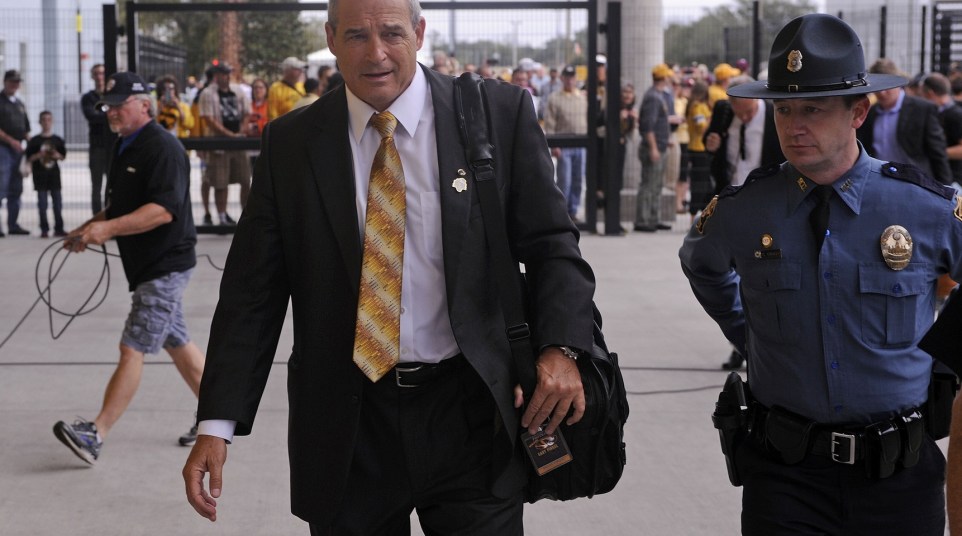Facilities upgrades always on the minds of coaches, athletic directors
Will Muschamp and Gary Pinkel, despite coaching for SEC competitors, are fighting the same fight.
For the majority of his tenure as Florida’s head coach, Muschamp wanted nothing more (other than a winning football team) than for the university to give the athletics facilities a makeover. Florida and athletic director Jeremy Foley finally conceded — three months after Muschamp’s departure.
Muschamp, when he arrived at Auburn, immediately lauded the Tigers’ facilities, saying recruits would come to Gainesville and tell tales of the facilities at Auburn.
“To see all the facility changes and all the nice things that have happened within this campus is awesome to see,” Muschamp said at his introductory press conference. “I see the wellness center, and I know the student on the recruiting trail all the kids that would come to Florida and come to Auburn, they’d tell me how nice the housing was here, so that’s good to be on that side of it now. I’m excited about that.”
Now, new Gators coach Jim McElwain reaps the benefits of the football facilities getting a “facelift,” starting with $15 million poured into an indoor practice facility, with total renovations costing as much as $60 million.
It’s proliferating throughout college football. Coaches and athletic directors, both old and new, realize they can’t win with outdated football facilities. Schools are taking heed, doing their best to keep up in the race to build the newest, most state-of-the-art facilities in the conference and country, with renovation and upgrade projects announced seemingly every year.
Steve Spurrier stumped for upgrades shortly after arriving at South Carolina, decrying the need for South Carolina to bring its old facilities into the modern era. Then-AD Eric Hyman listened, and five years later the Gamecocks had the Dodie Anderson Academic Enrichment Center, commonly referred to as “the Dodie,” a beautiful piece of recruiting material just for athletes.
Hyman took his knack for facilities upgrades to Texas A&M, where he’s overseeing one of the biggest renovation projects in college football. Hyman and Kevin Sumlin arrived in 2012, and in May 2013 the university approved $450 million in upgrades and renovations to Kyle Field and the team’s facilities, from a completely modern locker room to upping the stadium capacity to more than 100,000, making it the largest in Texas and in the SEC.
Not all coaches get what they want when they get to campus, or even more than a decade later. Gary Pinkel has been head coach at Missouri since 2001, and the university has made slow progress on getting the Tigers up to speed with the rest of the SEC’s rapid move toward modern facilities.
The university recently completed more than $46 million in stadium upgrades, adding the luxury suites that many schools have built in their latest stadium renovations, but Pinkel knows that’s not enough to keep Mizzou competitive. On his radio show back in the fall, Pinkel let the administration and Mizzou fans everywhere hear what he thinks needs to happen.
“The next thing we have to do — and we have to do it fast, we have to do it in the next few years — we have to build a facility down there in the south that wraps around there,” Pinkel said. “And it’ll have football offices, weight room, new locker room.”
While there might not be a direct correlation, you can’t help but wonder if the back-to-back East champions’ recruiting classes would rank higher if the facilities caught up with the rest of the SEC.
“Our offices are nice but, compared to everybody else in the league, they’re just average,” Pinkel continued. “We don’t want to be average at anything. We need to build that down there at the south end, and we don’t need to wait 6-8 years to get it done.”
Pinkel hit the nail on the head: Missouri’s facilities are just fine, but in the scope of the SEC they’re lagging behind. It’s the same thing Muschamp said about Florida’s facilities shortly after he left the school.
These types of upgrades aren’t a luxury item anymore; they’re a necessity if you want to keep up.

